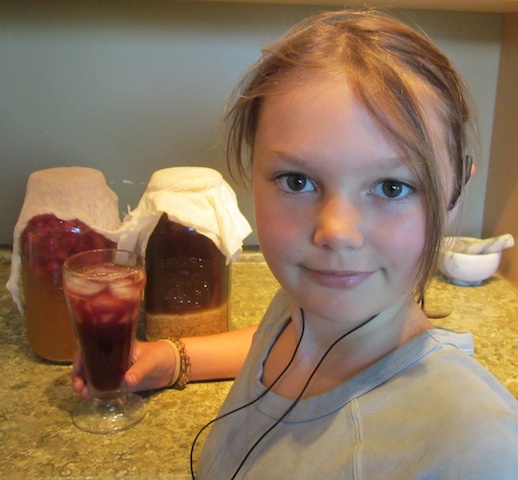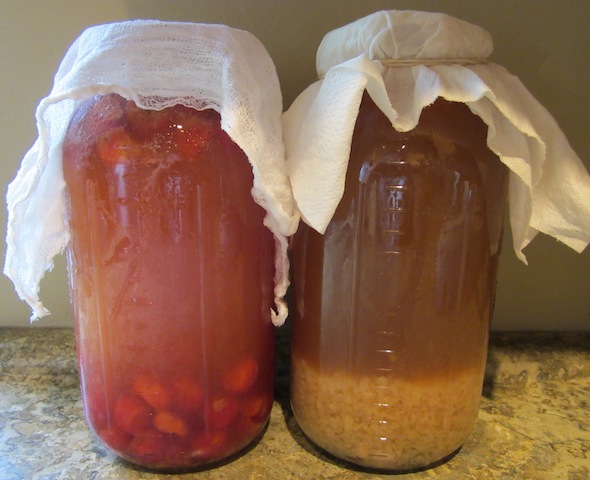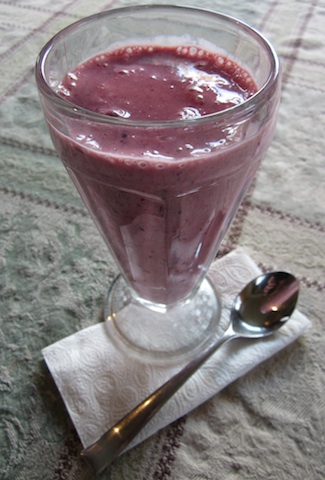
Here is Erika trying her sweet cherry flavored water kefir soda. It's hard to believe she was once a sickly child. She is also on the SCD/GAPS or modified paleo diet.
Traditional sodas are a wonderful beverage during hot summer days. They seem to hydrate better than water and that sour taste is so refreshing on a hot day.
Traditional sodas could be made for the hot days in Kamloops. If you have never tasted a traditional fermented soda, you are not alone. I had my first fermented drink only five years ago. I didn’t know what I was missing. I have been a committed drinker ever since.
If you would like to get your hands on some FREE culture please see I got culture! If you would like to learn more about the history and practice of fermentation please read Charles Eisenstein’s essay called Old-Fashioned, Healthy, Lacto-Fermented Soft Drinks.
Last week I had the great pleasure of meeting Mira Siemiatkowski. She was looking for some dairy kefir grains. Mira asked me if I would be interested in water kefir grains. I told her I had tried water kefir before but I wasn’t that fond of the yeasty flavor and actually preferred lacto-fermented beverages. Mira told me she had worked out a process that avoided the yeasty flavor of some water kefir sodas.
When Mira came up to get her dairy kefir grains she brought a sample of water kefir soda. Erika and I tried it. It was delicious and did not have that nasty yeasty flavor. Erika was so excited and wanted to make soda herself. This is the method Mira taught Erika. Erika really likes fermenting and has been enjoying traditional sodas all week.
Note about Equipment and Ingredients
Mira warned never use any metal utensils that could come in contact with your water kefir. Apparently, the culture does not like any metals. Fermentation is the only time you will ever see me using sugar. It is reported that all the sugars are consumed by the fermentation process.
Water kefir is a live culture. Use organic or un-sprayed produce and filter water without chloride or your culture may die from the pesticides or the anti-bacterial properties in chlorinated water.
Equipment
two 2L mason jars
cheesecloth
paper towel
rubber bands
Ingredients for Kefir Grain Jar
water kefir grains
3/4c organic sucanat, rapadura or white sugar
filtered water
whole organic lemon, peeled and squeezed
two organic dried apricots, peaches or prunes
Place the water kefir grains in the 2L mason jar. Heat up a pot with 2-3c of water and dissolve the sugar in the water. Add more water until you get to about 1.5L in volume. Add ice if the sugar solution is warmer than room temperature. Pour the sugar solution into the mason jar with the water kefir grains. Add two pieces of dried fruit and one whole peeled lemon. Give the whole lemon a good squeeze to release the juices before adding to the sugar solution. Cover the jar top with a paper towel or cheesecloth and secure with a rubber band. Sit the jar in a warm place for 24 hours.
Ingredients for Fruit Flavoring Jar
2-3c fresh or frozen organic fruit of your choice: sour cherries, sweet cherries, raspberries, strawberries, blackberries, blueberries, plums, grapes, peaches or apricots.
After the first 24 hour fermentation, transfer the fermented solution to the second 2L jar. Use the cheesecloth to catch all the kefir grains. After you have transferred the fermented solution to the second jar, add 2-3c of fresh or frozen organic fruit of your choice. If you are using fresh fruit, give the fruit a good squeeze to release juices into the fermenting solution. Different fruits will give different flavors to the soda. Let the fruit ferment in the solution for another 24 hours. At the end of the 24 hours use the cheesecloth to strain out the fermented fruit. Compost the fermented fruit or give it to your livestock. Don’t over ferment your soda. That is where the yeasty flavor comes from. Refrigerate the water kefir soda. It is ready to drink.
Keeping the Fermentation Process Going and Taking a Break
As soon as you pour off the fermented solution from the water kefir grains, you need to continually feed your culture. If you want to take a break from making water kefir, feed your culture by adding more sugar solution and then place the jar into the fridge. It will last for weeks with only one feeding under cold temperatures. Remember to give away your extra kefir grains to friends and family.




